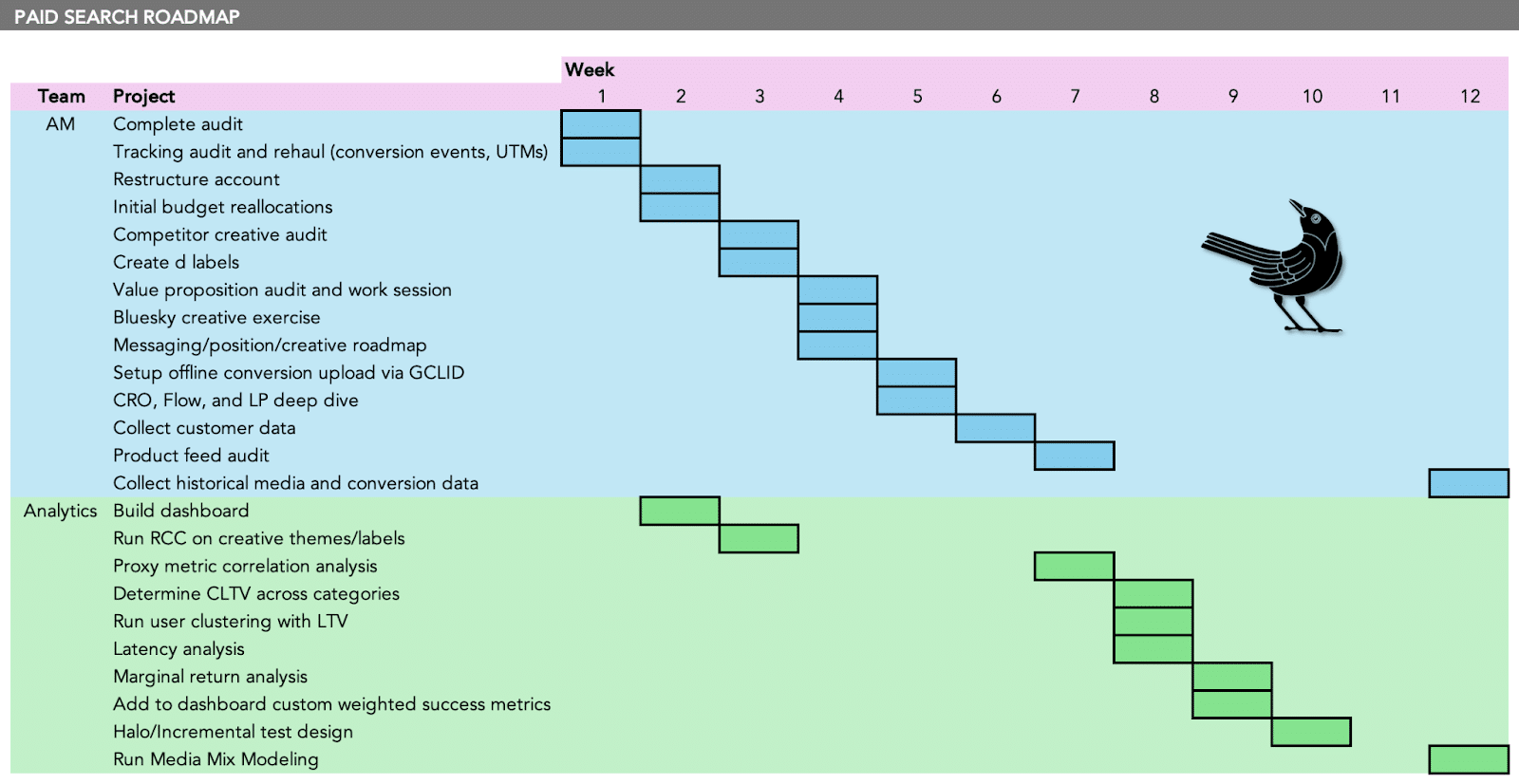How to create a roadmap for your PPC clients

Creating a roadmap is one of the most impactful initiatives we undertake for our clients. This comprehensive project offers significant benefits, regardless of the business’s growth stage.
Whether we’re working with a seed-stage startup or managing an enterprise-level PPC account, the primary goal is to outline strategic steps that drive marketing and broader business outcomes.
At my agency, we typically follow a six-stage process for developing roadmaps:
- Establishing the goals of the roadmap.
- Learning from past marketing efforts.
- Analyzing the current competitive landscape.
- Setting up measurement systems.
- Implementing a test-and-learn structure.
- Planning for scale.
Let’s take a closer look at each of these stages.
1. Establish your roadmap goalsTo create an effective roadmap, the first step is to clearly define the primary business goal we want to prioritize.
This goal could be focused on increasing revenue, building pipeline or acquiring new customers. It serves as the guiding star on our roadmap, directing our efforts and strategies.
From there, we establish the KPIs that lead to the business goal. That could look like:
- Session volume target.
- CPC target.
- CTR target.
- CVR target.
- CPA target.
- ROI target.
- Etc.
Because the roadmap incorporates a series of steps, measuring and reporting on those steps is important.
From a communication standpoint, the outcomes of a shared roadmap are transparency into performance and progress over time, with owners clearly defined for each step and synchronization between teams.
Even in a single-channel campaign with creative, bidding/targeting and lift tests to measure incrementality, there can be several owners.
Roadmaps are always important, but they become absolutely critical with more campaign complexity.
Dig deeper: 5 ways to align PPC campaigns with business objectives
2. Learn from the pastThis step depends on account maturity and history.
Startups will find it less useful, although all historical data (no matter how shallow) should be considered.
For all kinds of accounts, a roadmap’s second stage should be about gathering learnings from past marketing efforts. These include:
- An audit of campaign set-up and strategy that uncovers findings like lost impression share due to budget.
- In-platform analysis of keywords, ad groups, landing pages, etc.
- CRM analysis of lead stages, customer journey gaps and weaknesses, personas and lifetime value (LTV).
- Any relevant GA reports showing customer journey weaknesses and opportunities.
Dig deeper: 7 tips for conducting Google Ads audits
3. Learn from the presentThis step is highly relevant for all stages of growth. It’s important to get a snapshot of the current state to provide additional context for the historical learnings you just gathered.
A study of the present landscape includes:
- Market analysis (which focuses on customer needs and challenges).
- Competitor analysis (market share, positioning and channel presence).
Taken in aggregate, it should help you spot areas where your client can gain traction with both short- and longer-term strategies.
One step to include at this stage is reviewing Google’s automated campaign recommendations. Use a critical eye, but keep an open mind – not all of them are bad.
Dig deeper: How to benchmark PPC competitors: The definitive guide
Get the newsletter search marketers rely on.
Business email address Sign me up! Processing... 4. Measure, measure, measureAs we’ve probably beaten to death by now, a roadmap is a journey to an ultimate goal. This means that measuring progress and course-correcting along the way is an absolutely foundational piece.
The measurement systems we set up include:
- In-platform tracking (Google, Meta, LinkedIn, etc.).
- Google Analytics 4 tracking.
- UTM configuration.
- Cross-channel dashboarding.
The goal of all of these systems is not just to learn what worked; it’s to make better decisions about budgeting going forward.
At this point, some clients will have enough data (two years’ worth) to fuel media mix modeling analysis and help with budgeting decisions.
Many won’t, but in that case, our measurement work will build a foundation that will enable MMM analyses in the future.
Dig deeper: How to evolve your PPC measurement strategy for a privacy-first future
5. Test and learnWith measurement systems in place to see how things are working, it’s time to start testing.
Set up:
- Creative testing to identify the types of ads and messages that do well with your target audiences.
- Landing page testing to identify the design elements that work well with your target audiences.
- Channel expansion testing when you suspect there’s an opportunity to find new audiences on other platforms.
- Lift testing (we like geo lift testing, in particular) to measure which initiatives are truly incremental and reallocate budget according to the results.
Dig deeper: Incrementality testing in advertising: Who are the winners and losers?
6. Scale and improveThe chart below shows our standard timelines for the initiatives mentioned above, but a few of those initiatives are set up once and then locked forever.
We’re always looking for new tests to run, we run analyses like MMM and lift tests (and market/competitor research) at regular intervals, we’re in our accounts every day looking for optimization opportunities, etc.
Even if we’re knocking our overall goals out of the park, there is always room to be more efficient or find more scale (sometimes you can manage to do both, though it’s very difficult).

That’s the beauty and the challenge of marketing – you never really reach the end journey, not as long as your client’s business is up and running.
Final thoughtsThis roadmap is specific to PPC, but other marketing initiatives (social, SEO, email/lifecycle, content, etc.) should have similar systems to track their progress toward business goals.
One of the biggest challenges in marketing is to make sure that those initiatives are all working together, not redundantly or in silos – which is a topic for another article.
Dig deeper: Un-silo your PPC campaigns: 4 tactics for more cohesive marketing
